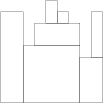https://codility.com/programmers/lessons/7-stacks_and_queues/stone_wall/
Question:
You are going to build a stone wall. The wall should be straight and N meters long, and its thickness should be constant; however, it should have different heights in different places. The height of the wall is specified by a zero-indexed array H of N positive integers. H[I] is the height of the wall from I to I+1 meters to the right of its left end. In particular, H[0] is the height of the wall's left end and H[N−1] is the height of the wall's right end.
The wall should be built of cuboid stone blocks (that is, all sides
of such blocks are rectangular). Your task is to compute the minimum
number of blocks needed to build the wall.
H[0] = 8 H[1] = 8 H[2] = 5 H[3] = 7 H[4] = 9 H[5] = 8 H[6] = 7 H[7] = 4 H[8] = 8
the function should return 7.
The figure shows one possible arrangement of seven blocks.

Assume that:
Write a function:
class Solution { public int solution(int[] H); }
that, given a zero-indexed array H of N positive integers specifying the height of the wall, returns the minimum number of blocks needed to build it.
For example, given array H containing N = 9 integers:class Solution { public int solution(int[] H); }
that, given a zero-indexed array H of N positive integers specifying the height of the wall, returns the minimum number of blocks needed to build it.
H[0] = 8 H[1] = 8 H[2] = 5 H[3] = 7 H[4] = 9 H[5] = 8 H[6] = 7 H[7] = 4 H[8] = 8
the function should return 7.
The figure shows one possible arrangement of seven blocks.

Assume that:
Complexity:
- N is an integer within the range [1..100,000];
- each element of array H is an integer within the range [1..1,000,000,000].
Elements of input arrays can be modified.
- expected worst-case time complexity is O(N);
- expected worst-case space complexity is O(N), beyond input storage (not counting the storage required for input arguments).
My Solution:
Notes:
1. main idea: need to use "stack" to check when we need a new block
Stack<Integer> st = new Stack<>();
2. // note: H[i] is the ith height of the wall
for(int i=0; i< H.length; i++){
// step 1: "stack is not empty" AND "from high to low"
// then, "pop" (it is the key point, be careful)
while( st.isEmpty()==false && st.peek() > H[i] ){
st.pop();
}
// step 2: if the stack is empty
if( st.isEmpty() ){
numBlock++; // add a block
st.push(H[i]); // push the height
}
// step 3: the height is the same: do nothing
else if( st.peek() == H[i] ){
}
// step 4: from low to high
else if( st.peek() < H[i] ){
numBlock++; // add a block
st.push(H[i]); // push the height
}
}
3. return the number of blocks
return numBlock;

No comments:
Post a Comment